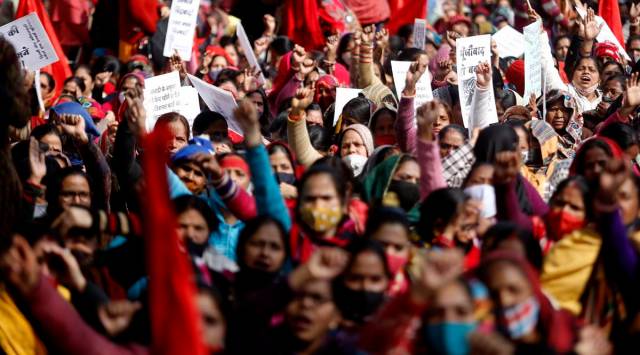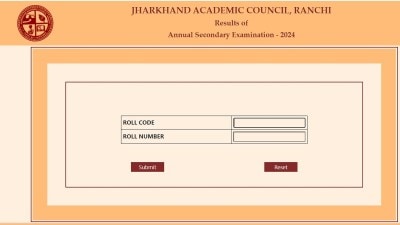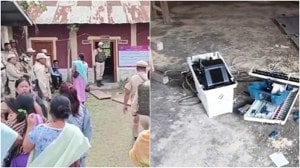- India
- International
Hardlook: The protests by anganwadi workers, helpers in Delhi and Gurgaon
Discontent among thousands of anganwadi workers in Delhi and Gurgaon has spilled to the streets, with women in both states pressing not just for better pay, but also full-time employment and associated benefits. A ground report
 The protest by anganwadi workers in Delhi has been going on near the Chief Minister’s residence for 20 days now. (Express Photo by Praveen Khanna)
The protest by anganwadi workers in Delhi has been going on near the Chief Minister’s residence for 20 days now. (Express Photo by Praveen Khanna)Underneath the sloganeering, chatter, and colours at the protests by anganwadi workers and helpers in Delhi and Gurgaon simmers a deep, silent unhappiness.
The immediate demand is straightforward: anganwadi workers in Delhi, where the protest has been going on near the Chief Minister’s residence for a week now, currently receive a monthly honorarium of Rs 9,678 and helpers receive Rs 4,839. Through their protest, they want this increased to Rs 25,000 a month for workers and Rs 20,000 for helpers. In Gurgaon, where their protest outside the Vikas Sadan enters its 61st day on Monday, workers receive Rs 11,811 per month and helpers receive Rs 6,045, which they want increased to Rs 24,000 and Rs 18,000 respectively.
To be sure, financial considerations and a need for security are at the heart of their demands, but deeply tied to this is a sense among these community caregivers that their labour is unrecognised and taken for granted.
Reena Shera, a 39-year-old anganwadi worker from Delhi, distinctly remembers feeling humiliated while running a creche at a voting centre during the last legislative assembly elections in the city. Across multiple voting centres on election day, creches had been set up to ease the voting experience for parents who had gone to polling booths with young children, and these were operated by anganwadi workers and helpers.
“We were there the entire time that voting took place and we had taken toys from our centre for this. But we were not offered lunch, any refreshments or even water, and there was no reward at the end of it. Sitting there, I really thought, ‘What is this work I’m doing?’ It felt like the helper and I were non-entities,” she said.

Anganwadi services are provided under the Integrated Child Development Scheme and each anganwadi centre — envisaged to cover a population of 1,000 each — is staffed by one worker and helper. Their work is classified as “honorary” and “not equivalent to any employment”. So, they are considered volunteers and are entitled to an honorarium.
Their regular responsibilities include running the centres, where they are supposed to impart some basic early education, distribute cooked meals and supplementary nutrition to children below the age of six years, and pregnant and lactating women; to maintain records of all mothers and children in their respective areas; to track the growth and weight of children below six years to monitor their nutrition; raise awareness and mobilise the community at the grassroots level for health and immunisation programmes. During the pandemic, in the absence of food distribution at the centres, they distributed dry ration door-to-door every month.
Apart from this, they also get women to fill forms for the Pradhan Mantri Matru Vandana Yojana and are roped in for community surveys for which they are supposed to receive some remuneration. However, workers state that instead of this, they want to be recognised as employees, receive a wage, and be entitled to the accompanying benefits.
“We have to maintain a monthly progress report which includes details of how many men and women there are in our respective areas, how many children, a record of how many people are SC, ST and OBC. We have to maintain manual records of this in registers and also update it on the Poshan Tracker app since its introduction, which means our work is doubled. We are also the ones who have been tracking which people in the community have got Covid vaccination and who have not, and have motivated them to get it. We also helped with door-to-door surveys to see who all have symptoms, who are at high risk,” said Neelam Rani (49).
Her core sentiment is echoed by women across protest sites in both states: “The governments keep introducing new programmes which is good, and because we have the best connection and relationships with communities, we get roped into them. We don’t have any problem with work, but we also want the dignity, pay and recognition that should come with it.”
Asha (40), an anganwadi helper, said she feels it even more deeply in her position: “We are just called helpers. People think that we do no work. Humara pad chhota hai par kaam bahut zyada hai (our position is small but work is big).”
“If we get the status of workers (majdoor), our economic condition would drastically improve as we would be entitled to social security benefits like PF, medical, pension and minimum wages. Currently, we are classified as ‘volunteers’ as per the government, but our duties are full time. During the pandemic, our work increased manifold… We did not fear for our lives and performed our duty as frontline workers,” said Saraswati (51), deputy state president of the Haryana anganwadi workers and helpers union.
According to sources at Delhi’s Department of Women and Child Development, Minister Rajendra Pal Gautam has given time to meet with the workers later this month and that options are being looked at.
“The department has been asked to look into their demands and resolve them to the extent possible but there are limitations. The Government of India is the parent authority of the scheme and regularisation can only be done through them. For the other work that they do such as surveys and for Pulse Polio, they receive additional honorarium. Their base honorarium is set by the Union government. All the state can do is increase its share of their payments slightly and this is being considered,” said an official.
In September 2018, the Prime Minister had announced that the Centre was increasing the honorarium of workers by Rs 1,500 and helpers by Rs 750. In both states, they say that the arrears of this hike are still pending.
For many of the women working as workers and helpers, the role presents a possibility to earn a living while completing their work at home as well. Their work hours are normally supposed to be from 9 am to 2 pm.
Meenakshi (46) has a Masters degree in Political Science. “I used to teach at a private school but had to leave because of some family troubles,” she said without elaborating on it. “I joined as a worker 16 years ago, when my daughter was young, thinking that I could do this while also looking after her. I thought that with time, I would be able to make some movement and become a supervisor in the department, but this has not happened,” she said.
Many of the women are also widows who started working after they lost their husbands.
Pushpa (41) had joined as an anganwadi helper in Delhi when her husband died 10 years ago: “My daughter was 6 and my son was 4, there was no one to look after them. I did not want to go work at, say, a factory, leaving them behind all day and working in an unsafe place with strange men.”
Nirmal (43), a worker in Gurgaon, joined after her husband suffered a sudden cardiac arrest in 2014 and died soon after. “I had two young daughters who were studying in school at the time. I desperately needed a source of income to look after them,” she said. But she has found that the work barely covers her expenses and said that Rs 3,300 out of her salary goes into paying rent for the centre in the city’s Om Nagar.
“The government only gives Rs 1,500 for renting the premises for the centre. It is impossible to rent a room for less than Rs 3,000 in a metropolitan city like Gurgaon. The balance rent is paid by us workers from our paltry salaries. Salaries are sometimes delayed for months. I often have to borrow money to make ends meet,” she said.
On December 29, 2021, after holding a meeting with a delegation of union workers, Haryana Chief Minister Manohar Lal Khattar had announced Rs 1 lakh for anganwadi workers and Rs 50,000 for helpers who retired from service on December 31.
In a statement, he had said that their monthly honorarium will be increased and the arrears for two years (2019-20 and 2020-21), and an incentive of Rs 1,000 each, will be given to anganwadi workers for working as frontline workers during the pandemic. He had added that anganwadi workers will be covered under the Ayushman Bharat scheme in the future.
A government official in Gurgaon, requesting anonymity, said that they had several meetings with the union workers to discuss their demands and were working to resolve them.
“A resolution has been worked out with at least two unions that are participating in the strike. One union (CITU) continues to protest and we are trying to resolve their demands. Some of the demands have been met. Recently, the monthly honorarium has been hiked by Rs 750 for workers and helpers and a formal letter in writing regarding it has been received. We are also working out issues related to renting of anganwadi centres in Gurgaon. It is difficult to rent out a room for the centre at Rs 1,500 in an urban area, but this has also been hiked recently,” said the official.
Apr 19: Latest News
- 01
- 02
- 03
- 04
- 05






































